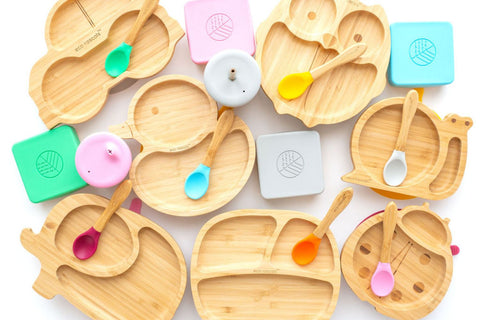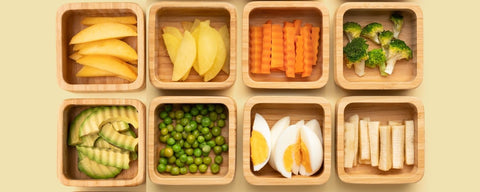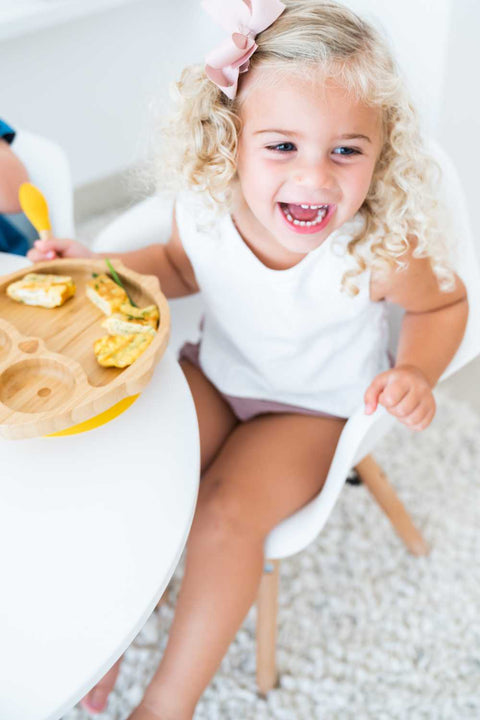Are Plastic Plates Safe? - Introduction
I grew up in the late 80s and early 90s when plastic plates and cups were a staple in every household. They were colorful, fun, and seemed indestructible. Because of that upbringing, many of us might think, "It hasn't harmed me, so what's the big deal?" But here's the thing—do we really know the long-term effects? Are Plastic Plates Safe, really? Our generation of children certainly faces more allergies and gut health issues than we ever did. Could that be linked to the microplastics we were unknowingly exposed to and have now passed down? What we do know today, which our parents didn’t, is that plastic is harmful to both our health and the environment. It’s time to do better and ask ourselves are plastic plates safe, for our own children.
💡 Did you know
Less than 10% of all plastic ever produced has been recycled. This means that a staggering 90% is still in use, sitting in landfills, polluting our oceans, or has been incinerated. Also, despite questioning are plastic plates safe? It still remains the most widely used material for children's tableware.
The Recycling Problem
Why does Plastic Tableware often end up in landfill?
- Plastic plates, cups, and cutlery are notoriously difficult to recycle. Unlike plastic water bottles, which are often made from recyclable materials, tableware is frequently manufactured from mixed plastics that can’t be easily separated and repurposed. This means that even if you place them in the recycling bin, there’s a good chance they’ll end up in a landfill instead.
- Adding to the issue, plastic tableware often becomes contaminated with food waste, which further complicates recycling efforts. Once discarded, these items don’t just disappear. Instead, they contribute to the growing global problem of plastic pollution, taking hundreds of years to break down fully.

The Health Risk - The Threat Of Microplastics
One of the most alarming concerns surrounding plastic tableware is the release of microplastics. When plastic plates, cups, and cutlery are exposed to heat—whether from hot food, dishwashing, or microwave use—they can leach harmful chemicals and break down into tiny plastic particles known as microplastics.
These microplastics can find their way into your child’s food and drink, posing significant health risks. Scientific studies have linked microplastics to a range of potential health problems, including:
Endocrine Disruption: Chemicals like BPA and phthalates, often found in plastic, can interfere with hormone regulation.
Immune System Impact: Exposure to microplastics may impair immune system function.
Developmental Concerns: Young children are particularly vulnerable to the effects of harmful chemicals, which may affect growth and cognitive development.
Given these dangers, it’s only natural to wonder, are plastic plates safe? The growing evidence suggests that they are not the best. choice for children’s mealtime needs.
Environmental Consequences
How Long Does Plastic Take to Break Down?
Another consideration when researching are plastic plates safe? is the pressing concern is how long plastic takes to degrade. A single plastic fork or plate can take up to 500 years to break down in a landfill. During this time, the plastic may fragment into microplastics, which persist in the environment indefinitely.
These tiny particles contaminate soil, waterways, and marine ecosystems. Wildlife often mistake microplastics for food, leading to ingestion and severe health issues. The damage doesn’t stop with animals—humans are also affected when microplastics enter the food chain.

The Bamboo and Silicone Solution
Let’s Do Better
Given the health and environmental risks associated with plastic tableware, it’s clear that we need to find better alternatives. Fortunately, eco-conscious parents have sustainable and safe options at their disposal.
Why Bamboo Tableware Is a Better Choice
Bamboo is a fast-growing, renewable resource that offers numerous benefits for children’s tableware:
Non-Toxic: Bamboo plates and cups are free from harmful chemicals like BPA, phthalates, and melamine.
Durable: Bamboo tableware is sturdy and can withstand the rough handling often associated with young children.
Biodegradable: Unlike plastic, bamboo breaks down naturally, making it an environmentally friendly choice.
Heat Resistant: Bamboo doesn’t release harmful chemicals when exposed to heat, making it safer for serving hot foods.
The Benefits of Silicone Tableware
Silicone is another excellent alternative to plastic:
Food-Grade Safety: High-quality, food-grade silicone is free from toxins and safe for children.
Durable and Long-Lasting: Silicone tableware can withstand high temperatures and rough use without breaking down.
Easy to Clean: Silicone is non-porous, making it resistant to bacteria and easy to clean.
Reusable: Unlike single-use plastic, silicone products are designed for long-term use, reducing waste.
Making the Switch: Small Steps for a Big Impact
Switching from plastic to bamboo or silicone tableware doesn’t have to be overwhelming. Start by gradually replacing frequently used items like plates, bowls, and cups. Look for trusted brands that prioritise safety and sustainability.
By choosing alternatives to plastic, you’re not only protecting your child’s health but also contributing to a cleaner, healthier planet. Every small step counts in reducing plastic pollution and safeguarding the environment for future generations.
At eco rascals, we offer a wide range of sustainable alternatives to plastic tableware, designed to suit children of all ages. Our silicone plate is thoughtfully designed to grow with your child. The removable divider makes it perfect for picky eaters or those experiencing food anxiety and transforms into an open plate as they develop more independence. Built to last, it’s an investment in both your child’s health and a greener future.
A Safer, Greener Future Starts at the Table
So, are plastic plates safe? The evidence strongly suggests that they are not the best option for your child’s health or the environment. The dangers of microplastics, the challenges of recycling, and the long degradation period of plastic make it clear that we need to do better.
Choosing bamboo and silicone tableware is a simple yet impactful way to make mealtimes safer and more sustainable. Whilst they both cost a little more to buy, as they cost more to produce, they will last for longer and retain their structure for longer. Let’s work together to protect our children and the planet—one plate at a time.








Comments (0)
There are no comments for this article. Be the first one to leave a message!